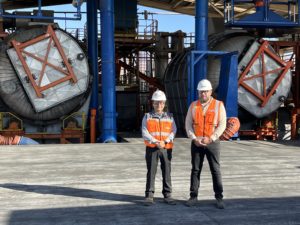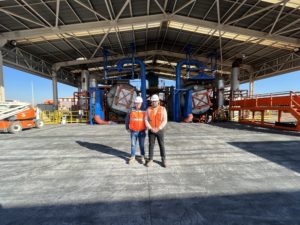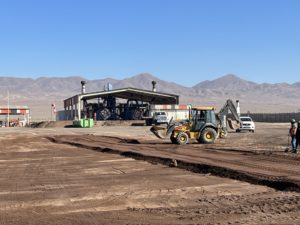In April 2023, IM Editorial Director, Paul Moore, toured Kal Tire Chile’s unique mining tyre recycling facility near Antofagasta with Rodrigo Reyes, Kal Tire Chile Recycling Plant Manager and Carlos Zuniga, Kal Tire Chile General Manager. There have been many attempts around the world to start up meaningful large mining tyre recycling capability based on pyrolysis – some remain on a small scale, but many others have closed either due to fires and safety incidents, or failure to get consistent results or have failed to achieve sustainability goals in terms of actual production of saleable byproducts.
Kal Tire’s Rodrigo Reyes & Carlos Zuniga faced up to many challenges to achieve a world leading process and facility

Canadian tyre management and service company Kal Tire has uniquely succeeded in establishing the world’s first commercial mining tyre recycling operation in La Negra, Chile – getting it right both in terms of the process itself, with saleable byproducts, but crucially doing so in a country where mining tyre recycling is now mandatory under the REP Law.
It is a serious business – if the law is not complied with, the tyre importer could be fined and unable to import any further tyres to Chile for a full year. And a number of other countries are looking at what is happening in Chile – already Peru is looking at enacting its own similar legislation and a number of Peruvian delegations from both the government and mining groups have visited the Kal Tire facility. The plant, known in Chile as RNG which stands for Reciclaje Neumaticos Gigantes (RNG), basically translated as Giant Tyre Recycling, has been developed over several years. The operation is now managed by a JV set up between Kal Tire and Mitsui & Co. in 2022.
The business case
It took a lot of effort and hard work dating back as far as 2016 – but it is now paying off – Bridgestone is now recycling its used tyres in Chile. The REP Law came into force in January 2023, and requires companies that import mining tyres to collect and recycle 25% of used tyres. But by 2027 the mandated recycling figure will increase from 25% to 75%, and by 2030, the target will further increase to 100%. As of today, all the many thousands of legacy tyres at mine sites, many of which are buried, are not affected by the law, but this could change in the future, and many mines may choose to deal with these tyres purely for sustainability reasons.
The customer is responsible to deliver the used tyres to the plant but Kal Tire can also offer this as a service if needed. The first stage of the process is a weigh bridge to confirm the weight of the tyres coming into the facility. According to the Chilean law, any tonnes of tyres that enter the facility must be accounted for in terms of the recycling process and resultant products.
The process begins with cutting each large tyre into pieces

It effectively becomes a closely monitored circular economy once the tyres cross the threshold. A certified scale is used that is recalibrated every six months. Another aspect is that Kal Tire charges customers based on the tons received. The mandated recycler and therefore the most likely customer is whoever imported the tyres that are now to be recycled into Chile in the first place – so in most cases this will be the big tyre makers – effectively Bridgestone or Michelin.
At the same time while the mines are not mandated to recycle their used tyres – they still have an environmental responsibility to do it and some are looking at it for that reason – during the IM visit, the first 63 in Bridgestone tyres arrived from El Abra mine, but up to this point, the facility had been recycling an initial volume of 2,500 t of Michelin 63 in tyres sent from AMSA’s Los Pelambres mine in 2021 – initially 100 tyres then the full batch after their executives came to see it themselves. This was a private arrangement outside of the REP Law. All these tyres were recycled as of May 2023 following the IM visit.
The plant is also highly certified – as an example it is undergoing ISO5001 inspections in terms of energy management, expected to be awarded later this year, and recently received International Sustainability and Carbon Certification (ISCC) PLUS certification verifying that its mining tyre recycling facility in Chile processes circular feedstocks. This will allow the products to be saleable in the European market.
From gate to market
After the tyres are weighed, they are stored – and Kal Tire has the right to store up to 4,000 t of 57 in and 63 in tyres on its property. Once the tyres are recorded and registered they are ready to begin the actual preparation and move to a cutting area, which uses a pair of specialised cutting machines. The tyres are thoroughly cleaned of dirt and dust first as this increases the cutting efficiency but also reduces contamination during the thermal conversion itself. The cutting machine is semi-automated, with the initial speed of the mechanism being inputted but then it carries out the cutting independently. The tyre is cut into six pieces, and after that each of the six pieces is put into the secondary cutter and cut into three pieces – so in total each large tyre ends up in 18 pieces. The process is intensive, but overall is it much cleaner than other processes that involve ripping or shredding tyres – less dust is created plus the regular pieces are much easier to handle.
IM’s Paul Moore with Rodrigo Reyes in front of the reactors in April 2023

The pieces are then moved to the business end of the plant – the two thermal conversion reactors themselves. Each one has a 20 t/d capacity. The tyre pieces are loaded into the reactors using a specially designed conveyor belt starting from the rear of the reactor to the front. At this stage Kal Tire still knows which particular used tyre is being recycled and the pieces are weighed a final time before being added. The authorities only want to know that the tonnage that entered the plant was recycled, but some mines also want to know what specific tyres were recycled. For Kal Tire the weighing is very important as well – due to mass balance calculations at the end of the process – comparing the tyre weight to derived products including fuel oil, carbon black, steel etc.
It is a very sequential process – one is being cooled down ready for a new batch while the other is working at high temperature. In the combustion chamber, the grey casing surrounding the reactor, temperatures reach over 500°C with temperatures inside the reactor itself varying based on the recipe required for the tyre structure and compound that will be processed. The process starts with LPG fuel but after a certain number of hours, syngas from the process starts to be produced which is reused in the heating process – another aspect that is unique to Kal Tire’s facility. This both reduces LPG consumption. The reactors constantly rotate the batch mass to transfer the heat evenly through all the tyre pieces.
So where did the design come from? Kal Tire initially asked an Italian company to design and assemble a system based on its needs – this was done initially in Italy including testing and review by a Kal Tire team, then it was disassembled and shipped to Chile for reassembly.
From when the burner is switched on to when it is switched off is 24 hours – this includes the heating and pyrolysis. This is followed by another 10 hours of cooling after which the direction of rotation also changes after the temperature finally drops to 80°C so that a screw system is able to recover the carbon black which by now is in a powder form. This is one of three products obtained along with tyre pyrolysis oil or TPO, a condensate from some of the gases produced by the burning rubber, and the steel cord itself. Some 6 t of steel cord is all that is left after all the carbon black is removed and by that stage has coalesced into a worm like structure – this is removed by a dedicated truck and then the process is complete. Some of the gases that cannot be condensed during the process are sent to a light oil tank where the gases are condensed using a water cooling system – some of this can then be sent back to the burner, again contributing to energy efficiency. In the combustion chamber heat is also recirculated.
The number one challenge, more so than getting required permits for the site, sourcing tyres themselves, or anything else – was getting this sequential process right. Reyes told IM: “From the very beginning the target was to be able to open the reactor and have steel without any rubber. And we were quickly able to do that, within 26 hours. But doing it at that speed means the syngas is generated over a short period such that it would not be able to be used in the process – and we would have no option but to flare it off, and that is not something that fits with our environmental and sustainable goals. You need to have the right ramp up of temperature over time at the right pressure to produce the syngas at a rate where it could self-fuel the process.”
One of the main characteristics of the Kal Tire plant versus other pyrolysis facilities is also that it is an automated system. Both lines can be digitally managed from the nearby control room and there is an emergency shutdown procedure if needed. Also if the system flags up any issues such as pressure exceeding set parameters, it will automatically put the plant in a safe condition mode where a valve is opened to relieve pressure and all the gases sent to flare. The reactors run 24/7 with the control room always staffed by two people – with teams operating on two 12 hour shifts.
Preparing the way for future expansion – and there is plenty of room to do it

Final products from OTR tyres
On to the final products – already today Kal Tire is selling its derived oil, steel and carbon black in the immediate region but at a relatively low price. This includes carbon black to the regional plastic, explosives and rubber industries, with the steel going for scrap to a steelmaker in Santiago.
To enhance the saleability of the carbon black a lot of R&D is going on at the site’s own lab and at Kal Tire’s Canada facilities. The powder from the process has high fines and volatiles and the research sees it go through a process of heating, milling and pelletising, with different pellet sizes aimed at different markets.
The heavy and light oils from the process are mixed in a tank and filtered to one product. Some of this oil is refined by a customer to a usable diesel similar to marine fuel, while some of the oil goes to the explosives market for mixing with ammonium nitrate in ANFO. Kal Tire has also bought its own 50 kW generator, and is already testing combinations of its refined oil with standard diesel along with additives to operate it.
Future potential
Overall, the RNG has the capacity to recycle 7,300 t per year of large mining tyres. The growth plan for Kal Tire at the site has the potential for the plant to expand to 22,000 t/y by the addition of two more pairs of identical reactors. There is no doubt this will happen and the area is already being prepared for it, but the exact timing will depend on the timing and size of new contracts. The existing storage and cutting area is sufficient to allow for this. And this will be badly needed as all the mining tyres imported since the beginning of 2023 start to filter through the system under the REP Law. Notably despite some noises, no other mining tyre recycling facilities on this scale or with this sophistication and sustainability have yet been developed in Chile.











